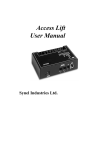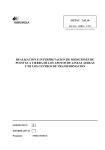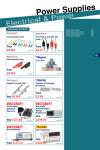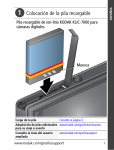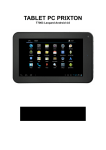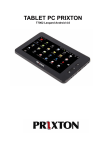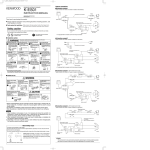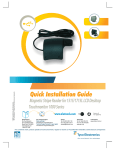Download Techno Sun - Elecsun 10A12/24V-LC-T
Transcript
ELECSUN 10A12/24V-LC-T SOLAR CHARGE CONTROLLER WITH LIGHTING CONTROL REGULADOR DE CARGA CON CONTROL DE ILUMINACIÓN ______________________________________ USER MANUAL / MANUAL DE USUARIO English version (EN) RATINGS 12V or 12/24V auto work. Elecsun 10A12/24V-LC-T 12V or 12/24V auto-work, 10A. NOTES: For use with solar panels only, for use with sealed battery in 12 or 24V systems. TECHNICAL INFORMATION Rated solar input Rated load 25% Current overload Load disconnect Load reconnect Equalization voltage (60 min.) Boost voltage (60 min.) Float voltage Temp Comp.(mV/ºC) Terminals Temperature 12Volt 24Volt 10A 10A 10A 10A 1 min. 1 min. 11.1V 22.2V 12.6V 25.20V 14.8V 29.6V 14.4V 28.8V 13.7V 27.4V -30mV -60mV Wire sizes to 2.5mm² -35ºC to +55ºC QUICK START INSTRUCTIONS This section provides a brief overview of how to get started using the controller. However, please review the entire manual to ensure best performance and years of trouble-free service. 1. 2. 3. 4. 5. Mount the controller to a vertical surface. Allow space above and below the controller for air flow. Make sure the PV and load currents will not exceed the ratings of the controller being installed. It is important to connect the battery first. We recommend that connections be made in order from 1 to 6 as per the diagram below. Note: carefully check before making each connection to be certain the polarity is correct. We strongly recommend connecting a fuse in the battery+ line near the battery. The fuse rating should be 1.5 times the controller current rating. Connect the BATTERY first. Make sure bare wires do not touch the metal case of the controller. Connect the SOLAR (PV array) next. The green LED indicator will light if sunlight is present. 6. Connect the LIGHT last. To verify system operation, read the next section and put the system in Mode 6. or 7. which will allow ON / OFF control via the switch. LIGHTING CONTROL OPTIONS 1. 2. 3. The ON / OFF switch has two functions. To turn the load on and off momentarily press the switch. To use it for setting options, press for 5 seconds to advance through the 16 work modes described below. The controller requires 10 minutes of continuous transition values before it starts to work. These constraints avoid false transitions due to lighting or dark storm clouds. The list below describes each of the modes, please note that the last 8 modes will have the point after the mode lit: Number 0 Number 1 Number 2 Number 3 Number 4 Number 5 Number 6 Number 7 Number 0. Number 1. Number 2. Number 3. Dusk-to-Dawn, light is on all night. Light is turned on after sundown for 1 h. Light is turned on after sundown for 2 h. Light is turned on after sundown for 3 h. Light is turned on after sundown for 4 h. Light is turned on after sundown for 5 h. Light is turned on after sundown for 6 h. Light is turned on after sundown for 7 h. Light is turned on after sundown for 8 h. Light is turned on after sundown for 9 h. Light is turned on after sundown for 10 h. Light is turned on after sundown for 11 h. Number 4. Number 5. Number 6. Number 7. Light is turned on after sundown for 12 h. Light is turned on after sundown for 13 h. Light remains turned off, on/off mode. Test mode, light on after it detects no light, light off after it detects light. LED INDICATOR ! Green ON when solar is charging battery. ! Green blink when the system over voltage. ! Green ON when battery level in the right range. ! Green slowly flashing when battery level full. ! Yellow ON when battery level low ! Red ON when loads cut off. ! Red ON when the output is on. ! Red slowly flashing when it is over load. ! (the load amps is 1.25 times of rated current for 60 seconds, or the load amps is 1.5 times of rated current for 5 seconds). ! Red fast flashing when the load is short-circuit. Please note: The output will be cut off once there is either short circuit or over load. While short circuit occurs, disconnect the loads and check the error loads, then press the switch, the load will be reconnected automatically after 3s. There is one automatic load reconnect attempts after 10s while first time short circuit. For more one time short circuit, users need press switch to reconnect loads. While the over load occurs, disconnect some loads and press the switch, the load will be reconnect automatically after 3s. TROUBLE SHOOTING 1. PV indicator is off when it is daytime a) b) c) d) e) The green Charging LED should be on during day time. Check that the proper battery type has been selected. Check that all wire connections in the system are correct and tight. Check the polarity(+ and -) of the connections. Disconnect the PV and measure the PV open-circuit voltage and confirm it is within normal limits. If the voltage is low or zero, check the connections at the PV array itself. With PV connected, measure the PV voltage and the battery voltage at the controller terminals. If the voltage at the terminals is the same (within a few tenths of a Volt), the PV array is charging the battery. If the PV voltage is close to the open circuit voltage of the panels and the battery voltage is low, the controller is not charging the batteries and may be damaged. 2. Charging LED indicator is blinking a) b) 3. First check the operating conditions to confirm that the voltage is higher than specifications. Consider the temperature compensation of the controller’s PWM setpoint. If the temperature lower than 0ºC the controller will regulate higher than 17V(17V is over voltage point). Check that all wire connections in the system are correct and tight. Problems with operation of load a) b) c) If Load LED is fast flashing, there is a short circuit. Look for short circuit. If Load LED is slow flashing, there is an overload condition. Check wiring to load, check connections. If you have multiple devices connected to the load, you may need to measure the current of each device to find defective device. Reduce the load, and press the switch button, the controller will turn on load after 30 seconds. If load is not operating, check that the load is turned on. Check that no system fuses are defective. Check connections to the load, and other controller and battery connections. Make sure voltage drops in the system wires are not too high. INSPECTION AND MAINTENANCE The following inspections and maintenance tasks are recommended at least once per year for best controller performance. 1. 2. 3. 4. 5. 6. 7. 8. Confirm that the current levels of the solar array and load do not exceed the controller ratings. Tighten all the terminals. Inspect for loose, broken, or burnt wire connections. Be certain no loose strands of wire are touching other terminals Verify the lights are working. This can be tested by putting controller in mode 18 or 19 and using the button as an on/off switch. Check that the controller is securely mounted in a clean environment. Inspect for dirt, insects and corrosion. Check the air flow around the controller is not blocked. Protect from sun and rain. Confirm that water is not collecting under the cover. Check that the controller functions and LED indicators are correct for the system conditions at that time. Make sure the PV array is clean and clear of debris and snow. Confirm the array is oriented correctly for the installation location. SYSTEM MAIN CIRCUIT DIAGRAM MECHANICAL DRAWING 4MOUNTING HOLES ¢4.0 (0.16) mm (inches) Notes _____________________________________________ _____________________________________________ _____________________________________________ _____________________________________________ _____________________________________________ _____________________________________________ _____________________________________________ _____________________________________________ _____________________________________________ _____________________________________________ _____________________________________________ _____________________________________________ _____________________________________________ _____________________________________________ _____________________________________________ _____________________________________________ _____________________________________________ Versión en español (ES) VALORES 12V or 12/24V automático. Elecsun 10A12/24V-LC-T 12V o 12/24V automático, 10A. NOTA: Para uso exclusivo con paneles solares, usar con baterías selladas en sistemas de 12 o 24V. INFORMACIÓN TÉCNICA Entrada nominal Carga nominal 25% corriente de sobrecarga Desconexión de carga Reconexión de carga Voltaje de ecualización (60 minutos) Elevación de voltaje (Bulk) (60 minutos) Voltaje de flotación Comp. de temp. (mV/ºC) Terminales Temperatura 12Volt 10A 10A 1 min. 11.1V 12.6V 14.8V 24Volt 10A 10A 1 min. 22.2V 25.20V 29.6V 14.4V 28.8V 13.7V 27.4V -30mV -60mV Cable calibre 2.5mm² -35ºC a +55ºC INSTRUCCIONES DE INICIO RÁPIDO Esta sección proporciona una breve visión general de como comenzar a usar el regulador. No obstante, por favor revise el manual completo para asegurar el mejor funcionamiento posible del regulador y evitar problemas en el futuro. 1. 2. 3. Monte el controlador en una superficie vertical. Deje espacio suficiente encima y debajo del regulador para permitir consultar las indicaciones impresas y permitir el flujo del aire. Asegúrese de que las corrientes de los paneles solares y de carga no excedan los valores permitidos por este regulador. Es importante conectar en primer lugar la batería. Recomendamos hacer las conexiones en orden desde el 1 hasta el 6 tal y como se indica en el diagrama inferior. Nota: compruebe antes cuidadosamente cada conexión para confirmar que la polaridad es correcta. Recomendamos firmemente conectar un fusible en la línea positiva cercana a la batería. La capacidad del fusible debería ser mínimo 1,5 veces mayor que el valor de corriente. 4. 5. 6. Conecte la BATERÍA primero. Asegúrese de que los cables pelados no toquen la caja metálica del regulador. Conecte a continuación la entrada SOLAR (línea de paneles FV). El LED indicador verde se encenderá si hay luz solar presente. Conecte finalmente la LUZ. Para verificar el funcionamiento del sistema, lea la siguiente sección y ponga el sistema en modo 6. o 7. que permitirá el control de encendido (ON) / apagado (OFF) a través del interruptor. OPCIONES DE CONTROL DE ILUMINACIÓN 1. El interruptor ON / OFF switch tiene dos funciones. Para cambiar entre estados ON/OFF la carga presione y suelte un instante el interruptor. Para usar el interruptor como configurador de las opciones, presiónelo durante 5 segundos para 2. 3. poder avanzar mediante pulsaciones entre los 16 modos de trabajo descritos a continuación. El regulador requiere 10 minutos de trabajo continuo antes de comenzar a trabajar. Esta limitación permite evitar falsos positivos por culpa de rayos o nubes tormentosas. La siguiente lista describe cada uno de los modos disponibles, por favor tenga en cuenta que los últimos 8 modos se distinguen de los anteriores por tener un punto después del número (0, 1, 2, 3, 4, 5, 6, 7, 0., 1., etc...): Modo 0 Modo 1 Modo 2 Modo 3 Modo 4 Modo 5 Modo 6 Modo 7 Modo 0. Modo 1. Modo 2. Modo 3. Modo 4. Modo 5. Modo 6. Modo 7. Desde el anochecer hasta el anochecer, luces encendidas toda la noche. Desde el anochecer durante 1 h. Desde el anochecer durante 2 h. Desde el anochecer durante 3 h. Desde el anochecer durante 4 h. Desde el anochecer durante 5 h. Desde el anochecer durante 6 h. Desde el anochecer durante 7 h. Desde el anochecer durante 8 h. Desde el anochecer durante 9 h. Desde el anochecer durante 10 h. Desde el anochecer durante 11 h. Desde el anochecer durante 12 h. Desde el anochecer durante 13 h. La luz permanece encendida o apagada permanentemente en base al estado indicado de ON / OFF. Modo de pruebas, luz encendida si no detecta luz, luz apagada si detecta luz. INDICADORES LED ! Verde encendido cuando la energía solar está cargando la batería. ! Verde parpadeando cuando hay sobrevoltaje. ! Verde encendido cuando el nivel de la batería está en el rango correcto. ! Verde parpadeando lentamente. cuando el nivel de la batería esté lleno. ! Amarillo encendido cuando la batería tiene nivel bajo. ! Rojo encendido cuando la carga se interrumpe. ! Rojo encendido cuando la salida está encendida. ! Rojo parpadeando lentamente cuando hay sobrecarga. (La carga en amperios es 1.25 veces el valor de corriente para 60 segundos, o la corriente de carga es 1,5 veces el valor de corriente para 5 segundos). ! Rojo parpadeando rápidamente cuando la carga está en cortocircuito. Nota importante: La salida será cortada si hay un cortocircuito o sobrecarga. Mientras ocurra el cortocircuito, desconecte las cargas y compruebe los errores de carga, a continuación presione el interruptor, la carga se reanudará después de 3 segundos. La primera vez que ocurra un cortocircuito habrá un intento de reconexión automática de carga después de 10 segundos. Si el cortocircuito ocurre más de una vez, el usuario necesitará presionar el interruptor manualmente para reconectar la carga. Cuando ocurra una sobrecarga, desconecte algunas cargas y presione el interruptor, la carga se reanudará automáticamente después de 3 segundos. SOLUCIÓN DE PROBLEMAS 1. El indicador de FV (paneles solares) está apagado cuando es de día a) b) c) d) e) La luz del LED de carga debe estar verde durante el día. Compruebe que se ha seleccionado el tipo de batería correcta. Compruebe que todas las conexiones de cables del sistema son correctos y están ajustadas. Compruebe la polaridad positiva y negativa de las conexiones. Desconecte la carga FV y mida el voltaje del sistema FV en circuito abierto y confirme si entra en los límites normales. Si el voltaje es bajo o cero, compruebe las conexiones de la línea de paneles solares Con la carga FV conectada, mida el voltaje de la la carga FV y de la batería en los terminales del regulador. Si el voltaje entre los terminales es la misma (con una diferencia de pocas décimas), la carga FV está cargando la batería. Si el voltaje de la carga FV es cercana al voltaje en circuito abierto y el voltaje de la batería es bajo, el regulador no está cargando las baterías y puede dañarse. 2. El indicador de carga LED está parpadeando a) b) 3. Compruebe en primer lugar las condiciones de funcionamiento para confirmar que el voltaje es mayor que las especificaciones. Considere la temperatura de compensación del regulador. Si la temperatura es menor que 0ºC el regulador regulará más de 17V (17V es el punto de sobrevoltaje). Compruebe que las conexiones de los cables del sistema están correctos y ajustados. Problemas en la operación de carga a) b) c) Si el LED de carga parpadea rápidamente es que hay un cortocircuito, localícelo. Si el LED de carga parpadea lentamente, entonces hay una sobrecarga. Compruebe el cable que va a la carga y sus conexiones. Si tiene varios aparatos conectados a la carga, puede ser necesario medir la corriente de cada aparato para encontrar cual es el defectuoso. Reducida la carga pulse el interruptor, el regulador volverá a cargar pasados 30 segundos. Si la carga no está funcionando, compruebe que la carga está encendida. Compruebe que no hay fusibles defectuosos. Compruebe las conexiones a la carga, y otras conexiones al regulador y la batería. Asegúrese que la caída de voltaje en el cableado del sistema no es demasiado elevado. INSPECCIÓN Y MANTENIMIENTO Las siguientes tareas de inspección y mantenimiento son recomendadas como mínimo una vez al año para un mejor rendimiento del regulador. 1. 2. 3. 4. 5. 6. Asegúrese que los nivel de corriente y carga en la línea de paneles solares no excede los valores permitidos por el regulador. Apriete bien las conexiones. Inspeccione en búsqueda de cables pelados, rotos o quemados. Asegúrese que no hay hebras de cable tocando otros terminales. Verifique que las luces funcionan correctamente. Esto puede comprobarse poniendo el regulador en modo 18 o 19 y usando el interruptor como encendido / apagado. Compruebe que el regulador está firmemente montado de forma segura en un ambiente limpio. Inspeccione frente a suciedad, insectos o corrosión. Compruebe que el flujo del aire alrededor del regulador no esté bloqueado. Proteja el regulador del sol y la lluvia. Asegúrese que no se acumula agua en la carcasa. 7. 8. Compruebe que las funciones e indicadores LED del regulador funcionan correctamente para las funciones del sistema en ese momento. Asegúrese de que el sistema fotovoltaico está limpio y libre de escombros o nieve. Confirme que la línea de paneles solares esté orientada correctamente para el lugar de instalación del sistema. DIAGRAMA ELEC. PRINCIPAL DEL SISTEMA DIAGRAMA MECÁNICO 4MOUNTING HOLES ¢4.0 (0.16) mm (inches) Notas _____________________________________________ _____________________________________________ _____________________________________________ _____________________________________________ _____________________________________________ _____________________________________________ _____________________________________________ _____________________________________________ _____________________________________________ _____________________________________________ _____________________________________________ _____________________________________________ _____________________________________________ _____________________________________________ _____________________________________________ _____________________________________________ _____________________________________________
























